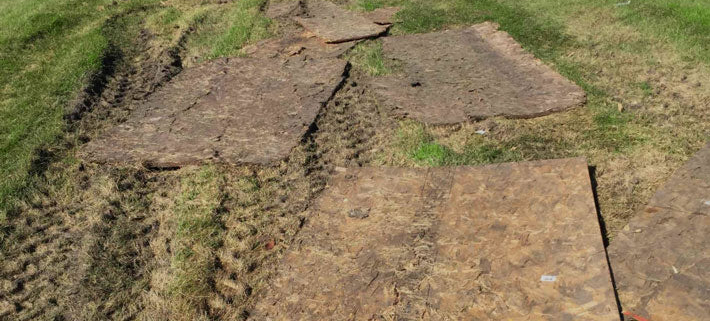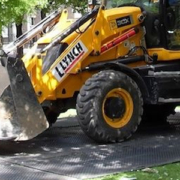Ground Protection Mats vs Plywood: A Comprehensive Analysis
When it comes to protecting the ground during heavy-duty activities, two primary options come to mind: ground protection mats vs plywood. Both serve the same fundamental purpose, but they offer distinct advantages and disadvantages. In this blog post, we’ll delve into a detailed comparison between ground protection mats and plywood alternatives, evaluating aspects such as durability, cost, ease of use, environmental impact, and safety.
1. Durability and Longevity
Ground Protection Mats:
Ground protection mats are specifically designed for high durability and long-term use. Constructed from high-density polyethylene (HDPE) or other robust plastics, these mats can withstand heavy loads, including multi-ton machinery and constant vehicular traffic. They are resistant to weather conditions, chemicals, and UV radiation, ensuring they don’t warp, crack, or degrade easily. This makes them ideal for repeated use across multiple projects, offering a lifespan that can extend several years with proper maintenance.
Plywood:
Plywood, while a versatile and readily available material, does not match the durability of ground protection mats. It can absorb moisture, leading to warping, swelling, and eventual disintegration, especially in wet or humid conditions. Plywood is also susceptible to cracking and splintering under heavy loads, reducing its lifespan significantly. Typically, plywood may only last for a few uses before it needs to be replaced, making it less durable in the long run.
2. Cost Effectiveness
Ground Protection Mats:
The initial cost of ground protection mats is higher compared to plywood. However, their longevity and reusability make them a cost-effective solution over time. The durability of these mats reduces the need for frequent replacements, lowering the overall expenditure for long-term projects. Additionally, many ground protection mats are made from recycled materials, which can sometimes reduce costs.
Plywood:
Plywood is cheaper upfront, making it an attractive option for short-term or one-off projects. However, its lack of durability means that it often needs to be replaced frequently, leading to higher cumulative costs over time. For projects that require continuous or long-term ground protection, the repeated purchase of plywood can quickly surpass the initial savings.
Plywoods lack of durability means that it often needs to be replaced frequently
3. Ease of Use and Installation
Ground Protection Mats:
Ground protection mats are designed for easy installation and removal. Many mats come with built-in handles or handholds, making them easier to maneuver and position. The interlocking systems, such as connectors or bolts, allow for secure and seamless connections between mats, ensuring stability. Typically, a two-person team can install these mats quickly without needing specialized tools or equipment.
Plywood:
Plywood sheets are relatively easy to handle due to their lightweight nature, but they can be cumbersome and require more effort to align properly. Installation often involves nailing or screwing the sheets together, which can be time-consuming and may require additional tools. Removing and reusing plywood can also be labor-intensive, especially if the sheets are damaged or warped.
4. Environmental Impact
Ground Protection Mats:
Many ground protection mats are made from recycled HDPE or other recycled plastics, making them an eco-friendly option. Their long lifespan and reusability further reduce environmental impact by minimizing waste. Additionally, the manufacturing process for these mats can be more sustainable compared to producing new plywood, which often involves deforestation and high energy consumption.
Plywood:
Plywood production involves cutting down trees, contributing to deforestation and the depletion of natural resources. The process also consumes significant amounts of energy and chemicals, which can be harmful to the environment. While plywood can be recycled or repurposed to some extent, its shorter lifespan and tendency to degrade quickly increase its environmental footprint compared to durable ground protection mats.
5. Safety
Ground Protection Mats:
Ground protection mats are designed with safety in mind. Their non-slip surfaces provide excellent traction for both vehicles and pedestrians, reducing the risk of slips and falls. The mats also distribute weight evenly, preventing ground subsidence and maintaining a stable surface. Additionally, their ability to link securely minimizes gaps and trip hazards, creating a safer work environment.
Plywood:
Plywood, especially when wet, can become slippery and pose a significant safety risk. It can also develop sharp splinters and edges when damaged, which can cause injuries. The uneven weight distribution on plywood sheets can lead to instability and potential ground damage, further increasing the risk of accidents.
6. Versatility and Customization
Ground Protection Mats:
Ground protection mats are highly versatile and can be used across a variety of terrains, including muddy, sandy, or uneven ground. They come in different sizes and thicknesses to accommodate different needs and can be customized with company logos or other markings. This versatility makes them suitable for construction sites, event grounds, landscaping, and more.
Plywood:
While plywood can also be used in various settings, its effectiveness is limited on very uneven or extremely wet ground. It lacks the customization options of ground protection mats and does not provide the same level of adaptability to different conditions. Plywood is more likely to shift or become unstable on challenging terrain, limiting its versatility.
Conclusion
In the comparison between ground protection mats and plywood alternatives, it’s clear that ground protection mats offer several significant advantages. They provide superior durability, safety, and environmental benefits, making them a more cost-effective solution over time despite their higher initial cost. Their ease of use, customization options, and ability to withstand various conditions further enhance their appeal.
They provide superior durability, safety, and environmental benefits, making them a more cost-effective solution over time despite their higher initial cost.
Plywood, on the other hand, may be suitable for short-term, low-budget projects due to its lower upfront cost. However, its limitations in durability, safety, and environmental impact make it less ideal for long-term or demanding applications.
Ultimately, the choice between ground protection mats and plywood should be based on the specific needs of the project, including budget, duration, environmental considerations, and safety requirements. For most heavy-duty and long-term applications, ground protection mats emerge as the superior choice, offering a reliable and sustainable solution for ground protection.





Leave a Reply
Want to join the discussion?Feel free to contribute!